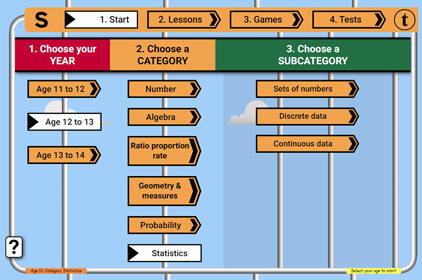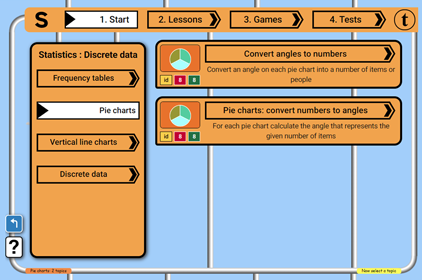


6th grade Algebra topics for Secondary math learners
| Topic icon key | ||
eq | Equation | Each item in the topic is in the form of an equation |
id | Identify | Each item in the topic is a thing |
mi | Missing item | Each item in the topic is a statement with a missing term |
10 | Number of items | There are 10 items in this topic |
8 | Extended items | Additional questions for games and tests in this topic |
Our math topics for 6th grade learners are designed to follow closely the Common Core standards for math for 6th grade pupils.
Algebra syllabus for 6th grade
Here are the key components of the math curriculum for algebra for children aged 11 to 12:
Variables and Expressions: Students expand their understanding of variables as symbols that represent unknown quantities or values. They practice evaluating and simplifying algebraic expressions, solving equations with variables, and translating word problems into algebraic expressions or equations.
Patterns and Relationships: Students explore more complex patterns and relationships in numbers and shapes. They identify and describe patterns, generalize rules, and extend patterns to make predictions. They also analyze patterns using tables, graphs, and formulas.
Linear Equations: Students delve deeper into linear equations and their solutions. They learn to solve one- and two-step equations and inequalities with integers and rational numbers. They apply inverse operations and properties of equality to solve equations and verify solutions.
Proportional Relationships: Students develop a deeper understanding of proportional relationships. They learn to recognize, represent, and solve problems involving direct and inverse proportions. They explore how to write equations and ratios to describe proportional relationships.
Functions: Students continue to explore functions and their representations. They learn to identify functions from tables, graphs, and equations. They analyze patterns in input-output relationships and explore the concept of function notation.
Coordinate Geometry: Students build upon their understanding of coordinate geometry. They learn to plot and interpret points in all four quadrants of a coordinate plane. They analyze patterns, symmetry, and relationships between points and shapes using coordinates.
Problem Solving: Algebraic thinking is applied to solve a variety of real-life and mathematical problems. Students analyze word problems, identify the relevant information, set up and solve algebraic equations or inequalities, and use algebraic strategies to find solutions. They also practice explaining their reasoning and justifying their answers.
Reasoning and Generalization: Students develop reasoning skills and make generalizations based on patterns and relationships. They investigate mathematical properties and relationships, articulate their thinking, and justify their conclusions using evidence and mathematical arguments.
The curriculum aims to foster a deeper understanding of algebraic concepts, problem-solving abilities, and reasoning skills. By the age of 11 to 12, students are expected to have a solid foundation in algebra and be ready to apply their knowledge in more complex mathematical contexts involving patterns, equations, functions, and problem-solving.
A topic is selected at the beginning of a session at Free Math Games and will be remembered when you move between games or activities. The math for the topic is carefully constructed to match the level of difficulty taught in US schools. This means that you as a secondary pupil should see similar math problems to those you are seeing at school (if you are at school) for any particular subject. Please let us know if that is not the case.
See the help box below for instructions on choosing a topic here at Free Math Games.
UXO * Duck shoot * The frog flies * Pong * Cat and mouse * The beetle and the bee
Rock fall * Four in a row * Sow grow * Choose or lose * Mix and match





How to choose a 6th grade Algebra topic for Secondary math

Click on the "1. Start" button in the top navigation bar - that brings you to this Secondary level topic selection page. On the topic selection page you will see that the topics are divided up:
- By level (Preschool, Elementary and Secondary)
- By grade (6th to 8th for this level)
- Into broad categories
Since you are currently within the Secondary section of Free Math Games you will see the Secondary topics. The Secondary grades will have loaded. Choose your grade. The broad categories available will load. Click on a category to see the available sub-categories and topics.

For example, if you choose 7th grade, then the category: "Algebra" and the sub-category "Sequences" you will be offered a choice of sub-sub-categories and topics suitable for your school grade - in the case of this example, "Generating terms" and "nth term expressions". Click on each sub-sub-category to view the available topics.
When you click on the name of a topic, the topic will load into the lesson page (once a topic has loaded it will be available for all activities and will not have to be downloaded again) and the lesson start page will be displayed. You can choose to do the lesson or jump immediately to the games using that topic.










